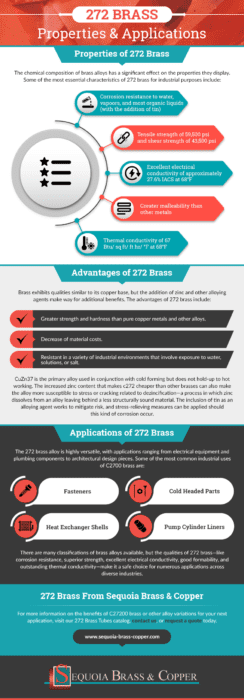Sequoia Brass & Copper has supplied high-quality brass, copper, and bronze to an array of industries for more than 35 years. Our team can assist in all your metal needs with custom-cutting capabilities, competitive pricing, and expert attention to quality and detail. Our product catalog includes a selection of brass materials, including alloy 272 brass tubing in a range of diameters and thicknesses.
Brass is a copper-zinc alloy known for its strength, machinability, conductivity, wear- and corrosion-resistance, and several other desirable properties. It is classified based on the amount of copper, zinc, and other alloying agents present in its chemical composition. Yellow brass, also known as 272 brass, c272 brass, or C27200, consists of 62-65% copper and approximately 37% zinc, as well as small percentages of lead, nickel, tin, and iron. CuZn37 is used extensively for industrial and architectural applications.
Properties of 272 Brass
The chemical composition of brass alloys has a significant effect on the properties they display. Some of the most essential characteristics of 272 brass for industrial purposes include:
Corrosion Resistance
The addition of tin to 272 brass creates an alloy that is resistant to water, vapors, and most organic liquids, making it well-suited to applications involving the transfer of or exposure to these substances.
Strength
Greater zinc levels in 272 brass improve strength and ductility, with a yield tensile strength of 59,500 psi and shear strength of 43,500 psi. This alloy’s strength is increased through cold-working, making it a good material for cold headed parts, fasteners, etc.
Electrical Conductivity
As a copper-based alloy, brass offers excellent electrical conductivity of approximately 27.6% IACS at 68°F. Conductivity decreases in relation to cold deformation and grain size.
Formability
An alloy’s formability refers to its capacity to withstand shape distortion without damage. Brasses like c272 offer greater malleability than other metals, allowing them to be cast into various shapes and sizes for use as tubing, liners, etc.
Thermal Conductivity
Yellow brass is often used to manufacture components for heat exchangers and other applications which require accelerated heat transfer across metal sections due to its outstanding thermal conductivity of 67 Btu/ sq ft/ ft hr/ °F at 68°F.
Advantages of 272 Brass
Brass exhibits qualities similar to its copper base, but the addition of zinc and other alloying agents make way for additional benefits. The advantages of 272 brass include:
- Greater strength and hardness than pure copper metals and other alloys.
- Decrease of material costs.
- Resistant in a variety of industrial environments that involve exposure to water, solutions, or salt.
CuZn37 is the primary alloy used in conjunction with cold forming but does not hold-up to hot working. The increased zinc content that makes c272 cheaper than other brasses can also make the alloy more susceptible to stress or cracking related to dezincification—a process in which zinc dissolves from an alloy leaving behind a less structurally sound material. The inclusion of tin as an alloying agent works to mitigate risk, and stress-relieving measures can be applied should this kind of corrosion occur.
Applications of 272 Brass
The 272 brass alloy is highly versatile, with applications ranging from electrical equipment and plumbing components to architectural design pieces. Some of the most common industrial uses of C2700 brass are:
- Fasteners
- Cold headed parts
- Heat exchanger shells
- Pump cylinder liners
There are many classifications of brass alloys available, but the qualities of 272 brass—like corrosion resistance, superior strength, excellent electrical conductivity, good formability, and outstanding thermal conductivity—make it a safe choice for numerous applications across diverse industries.
For more information on the benefits of C27200 brass or other alloy variations for your next application, visit our 272 Brass Tubes catalog, contact us, or request a quote today.

